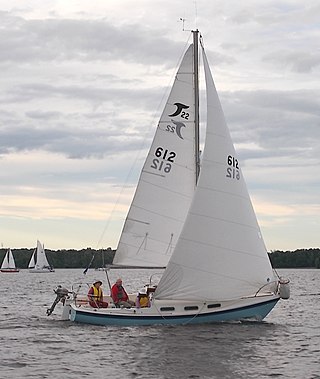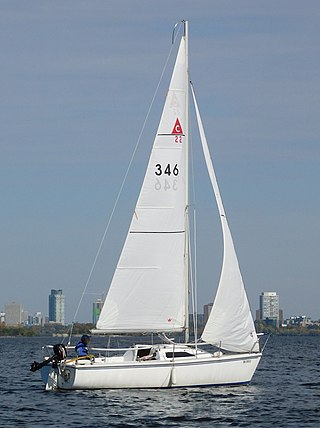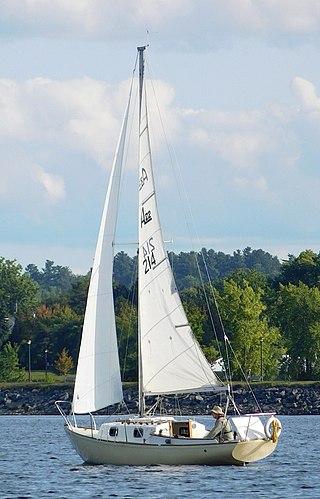Related Research Articles
The Santana 22 is an American trailerable sailboat, that was designed by Gary Mull and first built in 1966.

The Pearson Ensign, or Ensign 22, is an American trailerable sailboat that was designed by Carl Alberg as a one-design racer and day sailer and first built in 1962. It is the largest full-keel one-design keelboat class in the United States.

The US Yachts US 22 is an American trailerable sailboat, that was designed by Gary Mull and first built in 1979.
The Ranger 22 is an American trailerable sailboat designed by Gary Mull as an International Offshore Rule Mini Ton class racer and first built in 1977.
The Triton 22 is an American trailerable sailboat, that was designed by Gary Mull and first built in 1985. The design is out of production.

The Tanzer 22 is a Canadian trailerable sailboat, that was designed by Johann Tanzer and first built in 1970. The design went out of production in 1986.

The Capri 22 is an American trailerable sailboat, that was designed by Gary Mull and Frank Butler and first built in 1984.
The Fun 23 is a French trailerable sailboat, that was designed by Joubert-Nivelt for one design racing and first built in 1982. The design is out of production.
The Triton 25, also called the Pearson 25, is an American trailerable sailboat, that was designed by Gary Mull and first built in 1984. The design is out of production.

The DS-22 is a Canadian trailerable sailboat, that was designed by Bruce Kirby and first built in 1983.

The Starwind 223 is an American trailerable sailboat, that was designed by Cortland Steck and first built in 1984.

The Alberg 22 is a Canadian trailerable sailboat, that was designed by Swedish-American naval architect Carl Alberg and first built in 1970.

The Nonsuch 22 is a Canadian trailerable sailboat, the smallest of the series of Nonsuch sailboats. It was designed by Mark Ellis Design and first built in 1984.

The Spindrift 22 is an American trailerable sailboat that was designed by Jim Taylor Yacht Designs and first built in 1982.
The Hunter 22 is an American trailerable sailboat that was designed by the Hunter Design Team and first built in 1981.

The Marshall 22 is an American sailboat that was designed by Breckenridge Marshall as a cruiser and first built in 1965.
The Cape Dory 22 is an American sailboat that was designed by Carl Alberg as a cruiser and first built in 1981.

The Seaward 22 is an American trailerable sailboat that was designed by Nick Hake and first built in 1985.
The Typhoon Senior is an American trailerable sailboat that was designed by Carl Alberg as a cruiser and first built in 1984.

The Pearson 24 is an American trailerable sailboat that was designed by William Shaw as a cruiser and first built in 1967.
References
- 1 2 3 4 5 Browning, Randy (2018). "Electra (Pearson) sailboat specifications and details". sailboatdata.com. Archived from the original on 11 October 2021. Retrieved 11 October 2021.
- ↑ Browning, Randy (2018). "Carl Alberg". sailboatdata.com. Archived from the original on 11 October 2021. Retrieved 21 October 2020.
- ↑ Browning, Randy (2019). "Ensign (Pearson) sailboat specifications and details". sailboatdata.com. Archived from the original on 11 October 2021. Retrieved 11 October 2021.
- 1 2 3 4 Henkel, Steve: The Sailor's Book of Small Cruising Sailboats, page 190. International Marine/McGraw-Hill, 2010. ISBN 978-0-07-163652-0
- ↑ McArthur, Bruce (2021). "Pearson Yachts 1958 - 1990". sailboatdata.com. Archived from the original on 28 November 2021. Retrieved 11 October 2021.
- ↑ InterVisionSoft LLC (2018). "Sailboat Specifications for Pearson Electra". Sailing Joy. Archived from the original on 4 January 2019. Retrieved 3 January 2019.
- ↑ McArthur, Bruce (2021). "Pearson Yacht Owners Portal". sailboatdata.com. Archived from the original on 7 October 2021. Retrieved 7 October 2021.